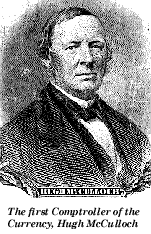  In
less settled parts of the country, lending standards tended to be more liberal. There
farmers could frequently obtain bank loans to buy land and equipment and finance the
shipment of farm products to market. Because of the unpredictability of weather and market
conditions, loan losses tended to be higher too. In
less settled parts of the country, lending standards tended to be more liberal. There
farmers could frequently obtain bank loans to buy land and equipment and finance the
shipment of farm products to market. Because of the unpredictability of weather and market
conditions, loan losses tended to be higher too. When the second Bank of the United
States went out of business in 1832, state governments took over the job of supervising
banks. This supervision often proved inadequate. In those days banks made loans by issuing
their own currency. These bank notes were supposed to be convertible, on demand, to cash
-- that is, to gold or silver. It was the job of the bank examiner to visit the bank and
certify that it had enough cash on hand to redeem its outstanding currency. Because this
was not always done, many bank note holders found themselves stuck with worthless paper.
It was sometimes difficult or impossible to detect which notes were sound and which were
not, because of their staggering variety.
By 1860 more than 10,000 different bank notes circulated throughout the country.
Commerce suffered as a result. Counterfeiting was epidemic. Hundreds of banks failed.
Throughout the country there was an insistent demand for a uniform national currency
acceptable anywhere without risk.
 In response, Congress passed the
National Currency Act in 1863. In 1864, President Lincoln signed a revision of that law,
the National Bank Act. These laws established a new system of national banks and a new
government agency headed by a Comptroller of the Currency. The Comptroller's job was to
organize and supervise the new banking system through regulations and periodic
examinations. In response, Congress passed the
National Currency Act in 1863. In 1864, President Lincoln signed a revision of that law,
the National Bank Act. These laws established a new system of national banks and a new
government agency headed by a Comptroller of the Currency. The Comptroller's job was to
organize and supervise the new banking system through regulations and periodic
examinations.
More of the Changing World of Banking:
 Introduction Introduction 1790 to 1832 1790 to 1832 1832 to
1864 1832 to
1864
 1865 to 1914 1865 to 1914  1929 to 1970 1929 to 1970  1970 to Today 1970 to Today
|




 In response, Congress passed the
National Currency Act in 1863. In 1864, President Lincoln signed a revision of that law,
the National Bank Act. These laws established a new system of national banks and a new
government agency headed by a Comptroller of the Currency. The Comptroller's job was to
organize and supervise the new banking system through regulations and periodic
examinations.
In response, Congress passed the
National Currency Act in 1863. In 1864, President Lincoln signed a revision of that law,
the National Bank Act. These laws established a new system of national banks and a new
government agency headed by a Comptroller of the Currency. The Comptroller's job was to
organize and supervise the new banking system through regulations and periodic
examinations.